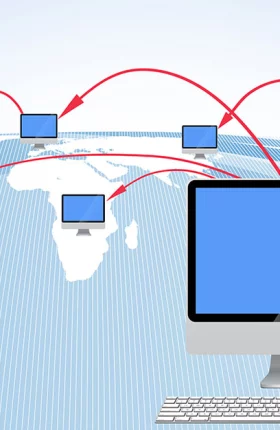Slowing growth, loss of momentum, maybe even a mid-life crisis: The IT services industry is showing all the signs of a maturing industry.
For many providers, competitive dynamics have turned for the worse, eating into profits and making it all too easy for customers to recompete existing contracts midstream—that is, put them up for competitive rebidding—or terminate them outright. Offshoring has seen its promise largely realized—and can be limited by political pressure, to boot. Many anticipated efficiencies have not fully materialized. Technology shifts—like the cloud—can make established processes seem dated. What was once a fruitful partnership between providers and customers has become, in numerous cases, a rocky one. And as in any troubled relationship, everyone involved is asking the same question, Where do we go from here?
To be sure, IT services companies can take some tried-and-true steps to alleviate the strain. They can reduce complexity, embrace automation, and ensure standardization. They can champion process excellence so that things get done right the first time. And they can adopt metric-driven operations so that results are easier to measure. All of these levers need to be pulled.
But providers shouldn’t stop there. Instead, they should build on these improvements and take their business, and their prospects, to the next level—by completely transforming their business model.
By now, the traditional “your mess for less” business models for IT services are so well established that it is rare to see a deviation. Yet the old ways are a poor fit with the new realities of the industry. Pricing based on technical drivers, such as the number of servers managed or the total terabytes of storage provided, give providers little incentive to invest in efficiency-boosting technologies such as virtualization and end-to-end provisioning systems. Traditional models also fail to provide a variable cost structure that is better suited to today’s economic climate; instead, customers pay the same whether their business is slow or booming.
Yet if pricing were based on the customer’s business drivers, these problems could be overcome. Customers would see their IT costs align with their business performance, and they’d get better processes, too—since a provider that is no longer being paid by the terabyte or the server has an incentive to do the work as efficiently as possible.
Meanwhile, pricing based on business drivers would enable providers to bundle all the services that relate to those drivers. The services would therefore become stickier because customers would no longer find it so easy to divvy them up among various vendors.
Already, we are seeing a first step toward this new business model. Cloud-based offerings like Amazon Web Services (AWS) offer utility-style pay-as-you-go pricing for storage, database hosting, and other infrastructure-centric services. Giving customers the ability to scale capacity—and costs—according to their needs has proved an attractive value proposition. AWS is estimated by some analysts to be a $1.5 billion annual business, an amount that places it within throwing distance of the top 25 data-center outsourcers.
There is a message in that success: While Amazon’s model works well for infrastructure services, it doesn’t have to end there. Providers of IT services can learn from it, build upon it, and bring a similarly attractive value proposition to customers who outsource complex business applications. The key is transforming normally fixed prices into variable ones—a process called variabilization.
Creating a new business model is never an easy task; transforming one that has been so established for so long is more challenging still. But we see a step-by-step path that can get the IT services industry well on its way. By following the recommendations below, providers not only can tackle the challenges they now face but also build a foundation for success—both for themselves and their customers.
Step 1: Understand the Customer’s Business—Especially Its Data
The first thing providers need to do is scrap all the questions they have traditionally asked at the start of an engagement and draw up a new list. Not surprisingly, IT services companies tend to ask about IT: How many data centers does a customer have? Where are they located? What are the main applications? In which environments do they run? But providers should also be asking about the business—homing in on the factors that determine success for the customer. What activities drive revenues? What processes support them? What data are used to track critical outcomes? In short, providers shouldn’t even begin an engagement before they thoroughly understand what the customer’s business is about, how that is delivered, and how it can be measured.
By asking and answering these questions, providers will be able to see how processes can be shaped to achieve the customer’s business goals, how they can be aligned with revenue, and—significantly for the provider—how they can be integrated and bundled to make them stickier. This approach enables IT services companies to home in on drivers and metrics that can link pricing to the customer’s business performance. And it leads, in the end, to more satisfied customers—and a lower likelihood that clients recompete their contracts.
Step 2: Define Relevant Business Drivers
Typically there is a direct link between an outsourced service and business performance, making it relatively easy—given knowledge of the customer’s business—to define the relevant business drivers. For managing a wireless carrier’s CRM system, the business driver could be the number of subscribers; for manufacturing systems, it could be the number of units produced. For an airline reservation system, pricing could be based on the number of reservations made, or on the number of boarded passenger miles.
Applications that enable, but don’t directly support, business processes—such as business intelligence or data warehousing—will present a bigger challenge. An approach we recommend is bundling such enabling capabilities into the prices of core business transactions; this requires factoring in business intelligence, for example, when setting the price for a service that is clearly linked to business performance. (It also assumes, of course, that the provider does not offer a deal exclusively focused on business intelligence.)
A business driver should be simple enough that the customer can see the benefit of the model. If it is too complex or nuanced, the driver can obscure the value proposition. Indeed, the best drivers not only are trackable with reasonable effort but also align with what the client is tracking in general.
Step 3: Zero In on Price
The right business driver will give providers a sound metric for aligning a customer’s IT costs with its performance. But providers will still need to put a price on that metric. How much, for example, should they charge for one completed airline reservation? Or one passenger mile? Or one wireless subscriber?
First, providers need to break down the service they are offering into layers—that is, all the individual components that make it happen. For an airline reservation system, this could be mainframe, network, storage, application maintenance, and end-user support. The costs for each component should be aggregated, then correlated to the business driver. One approach is to use historical data from the customer—for instance, the number of reservations made in previous years—to get an idea of how costs have mapped to drivers in the past.
Next, providers need to understand the value the service creates for the customer. Combined with an accurate cost picture, this insight lets the provider develop a value-based price that ensures adequate, even attractive, margins for itself—while delivering variable, on-demand-type pricing for its customers.
Step 4: Optimize the Delivery Model
While the transformed business model gives customers a variable cost structure, it also means that providers may have to contend with spikes and troughs in capacity. These can be smoothed out by building in multitenant deployments, which would help balance the load—and keep revenues flowing.
Providers will also need to manage their own supply chain, operating model, and offshoring aggressively. For example, by developing contracts based on usage or on just-in-time support with their equipment vendors and other suppliers, providers can mimic the risk profile of their revenues in their own cost structure. In this way, when business ebbs, costs decrease—just as it does for their customers.
Finally, it is important to establish a continuous improvement process to optimize the delivery model. New technologies should be leveraged whenever they can boost efficiencies or cut costs. Collaboration with customers should be encouraged, and ongoing. This will help to create faster, better ways to get the job done—and help strengthen relationships.
A Win for Everyone
Perhaps the most compelling aspect of the new business model is that it is a win for all sides. Providers wind up with stickier services, less churn among customers, and potentially higher margins. Customers get the greater efficiency in IT infrastructure that they’ve long desired, more customized services, and pricing that aligns far more closely with how their business is faring. The customer’s end-users benefit, too, as more efficient, more integrated processes should deliver better, and faster, results—and an improved overall experience.
IT services providers may be facing challenges, but a transformed business model can enable them to find opportunity and reignite sustainable growth. It’s a path providers can, and should, start down today.





